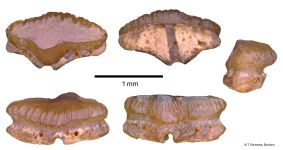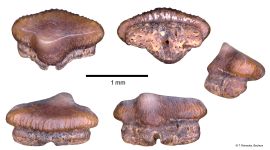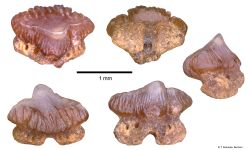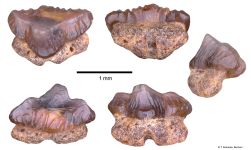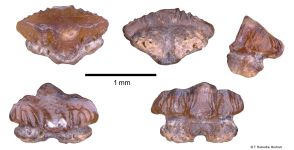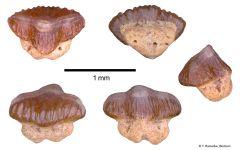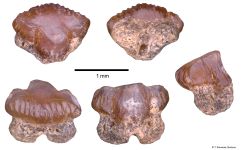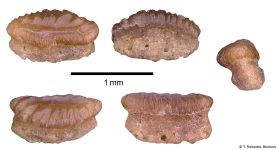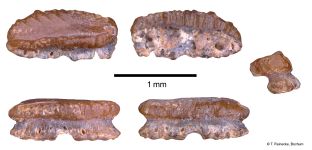Mustelus vanderhoefti
Herman, 1982
Classification: Elasmobranchii Carcharhiniformes Triakidae
Reference of the original description
Additions to the Eocene fish fauna of Belgium. 5. The discovery of Mustelus teeth in Ypresian, Paniselian and Wemmelian strata. Tertiary Research, 3(4), 189–193
Additions to the Eocene fish fauna of Belgium. 5. The discovery of Mustelus teeth in Ypresian, Paniselian and Wemmelian strata. Tertiary Research, 3(4), 189–193
Image of the original description
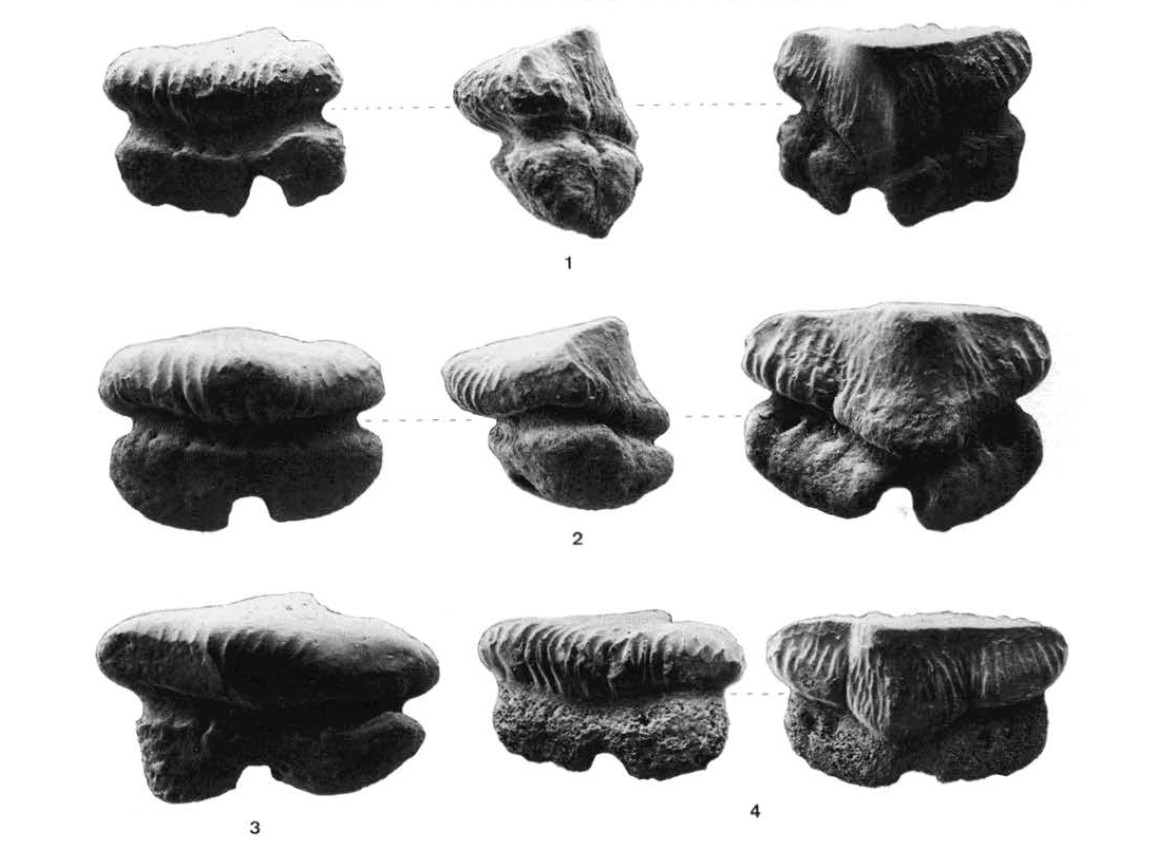
Mustelus vanderhoefti Herman, 1982, Egem (53W71) Venericor planicosta layer, 1) Coll. S.G.B. 53W71 P3, 2) holotype. Coll. S.G.B. 53W71 P1, 3) Coll. S.G.B. 53W71 P4, 4) Coll. S.G.B. 53W71 P5, all the extern faces are 30 x enlarged.

Mustelus vanderhoefti Herman, 1982, Egem (53W71) Venericor planicosta layer, 1) Coll. S.G.B. 53W71 P3, 2) holotype. Coll. S.G.B. 53W71 P1, 3) Coll. S.G.B. 53W71 P4, 4) Coll. S.G.B. 53W71 P5, all the extern faces are 30 x enlarged.
Synonyms / new combinations and misspellings
Mustelus aff. vanderhoefti, Mustelus cf. vanderhoefti
Mustelus aff. vanderhoefti, Mustelus cf. vanderhoefti
Types
Mustelus vanderhoefti
Mustelus vanderhoefti
Description:
Citation: Mustelus vanderhoefti Herman, 1982: In: Database of fossil elasmobranch teeth www.shark-references.com, World Wide Web electronic publication, Version 12/2025
Please send your images of "Mustelus vanderhoefti" to info@shark-references.com
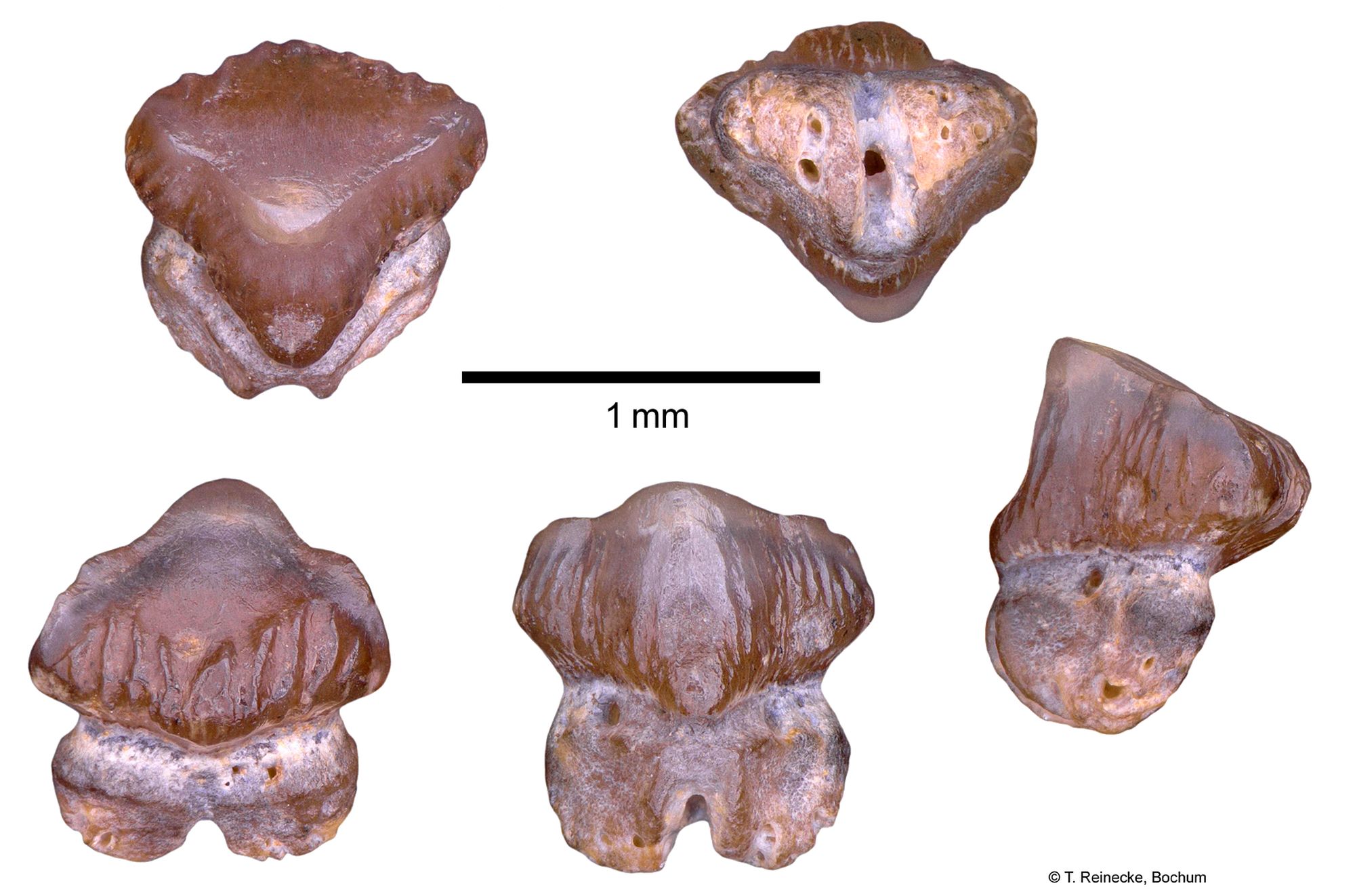
Mustelus vanderhoefti Herman, 1982, London Clay Formation, Division D, Sheppey Member, Ypresian, early Eocene; Cliff Reach, Burnham-on-Crouch, UK © T. Reinecke, Bochum

Mustelus vanderhoefti Herman, 1982, London Clay Formation, Division D, Sheppey Member, Ypresian, early Eocene; Cliff Reach, Burnham-on-Crouch, UK © T. Reinecke, Bochum
Description
Original description after Herman (1982) p. 191 [1122]:
Specific diagnosis: Mustelus showing massive and thick set teeth, with a very strong and high crown striation, so that a lot of striae rise to the upper part of the crown.
Derivatio nominis: In honour of my friend Eric VANDERHOEFT, official collaborator of the Belgian Geological Survey.
Material: Egem 53W71, layer with Venericor planicosta lenses, absolute level+ 39 m.: 5 teeth (Holotype + 4 Paratypes) S.G.B. Coll.
Holotype: The tooth illustrated in plate 1, fig. 2; no. 53W71 Pl.
Description and discussion: The holotype is a very well preserved anterior tooth of a total height of 1.30 mm., crown height 0.85 mm., 1.75 mm. long and 1.45 mm, wide. The others are considered to be antero-lateral, two laterals and one extreme lateral tooth. The smallest is 1.50 mm. long, the largest 2.10 mm. The median cusp is quite imperceptible, a good reason to consider this fossil form a true Mustelus and not as a member of the Rhinotriakis henlei group. The internal and external basal striations of the crown are very strong and their strength reduces progressively near the upper face (occlusal) of the crown, where they are tenuous and more or less undulated. They are relatively more elongated than those pf modern species examined. They seem larger on lateral than anterior teeth. The root is massive, deeply hollowed and shows numerous lateral pits on both faces. Teeth of modern species seem to have significantly reduced this number of secondary rootpits. These teeth differ from M. whitei Cappetta 1976 by their stronger and more expanded ornamentation, by their more massive aspect and by their larger size.
Original description after Herman (1982) p. 191 [1122]:
Specific diagnosis: Mustelus showing massive and thick set teeth, with a very strong and high crown striation, so that a lot of striae rise to the upper part of the crown.
Derivatio nominis: In honour of my friend Eric VANDERHOEFT, official collaborator of the Belgian Geological Survey.
Material: Egem 53W71, layer with Venericor planicosta lenses, absolute level+ 39 m.: 5 teeth (Holotype + 4 Paratypes) S.G.B. Coll.
Holotype: The tooth illustrated in plate 1, fig. 2; no. 53W71 Pl.
Description and discussion: The holotype is a very well preserved anterior tooth of a total height of 1.30 mm., crown height 0.85 mm., 1.75 mm. long and 1.45 mm, wide. The others are considered to be antero-lateral, two laterals and one extreme lateral tooth. The smallest is 1.50 mm. long, the largest 2.10 mm. The median cusp is quite imperceptible, a good reason to consider this fossil form a true Mustelus and not as a member of the Rhinotriakis henlei group. The internal and external basal striations of the crown are very strong and their strength reduces progressively near the upper face (occlusal) of the crown, where they are tenuous and more or less undulated. They are relatively more elongated than those pf modern species examined. They seem larger on lateral than anterior teeth. The root is massive, deeply hollowed and shows numerous lateral pits on both faces. Teeth of modern species seem to have significantly reduced this number of secondary rootpits. These teeth differ from M. whitei Cappetta 1976 by their stronger and more expanded ornamentation, by their more massive aspect and by their larger size.
Remarks
shark-references Species-ID=3827;
shark-references Species-ID=3827;
References
Combining palaeontological and neontological data shows a delayed diversification burst of carcharhiniform sharks likely mediated by environmental change. Scientific Reports, 12, Article 21906
DOI: 10.1038/s41598-022-26010-7
Feeding ecology has shaped the evolution of modern sharks. Current Biology, 31(23), 5138–5148
DOI: 10.1016/j.cub.2021.09.028

Eocene Carcharinidae and Triakidae (Elasmobranchii) of Crimea and Kazakhstan. Leipziger Geowissenschaften, 20, 1–57
New fossil triakid sharks from the Eocene of Prémontré, France, and comments on fossil record of the family. Acta Palaeontologica Polonica, 53(3), 433–448
DOI: 10.4202/app.2008.0306

Late Eocene sharks of the Hardie Mine local fauna of Wilkinson County, Georgia. Georgia Journal of Science, 61(3), 153–179

De visfauna uit de basis van de Klei van Egemkapel in de groeve Ampe te Egem (onder eoceen van Noordwest -Belgie) Tielt, 1994

Soortenlijst van fossiele vissen uit het Eoceen van België. Afzettingen WTKG, 15(4), 6–12

Fossils from the Bracklesham Group exposed in the M27 Motorway excavations, Southampton, Hampshire. Tertiary Research, 12(3–4), 131–137

Additions to the Eocene fish fauna of Belgium. 5. The discovery of Mustelus teeth in Ypresian, Paniselian and Wemmelian strata. Tertiary Research, 3(4), 189–193
Combining palaeontological and neontological data shows a delayed diversification burst of carcharhiniform sharks likely mediated by environmental change. Scientific Reports, 12, Article 21906
DOI: 10.1038/s41598-022-26010-7
Feeding ecology has shaped the evolution of modern sharks. Current Biology, 31(23), 5138–5148
DOI: 10.1016/j.cub.2021.09.028

Eocene Carcharinidae and Triakidae (Elasmobranchii) of Crimea and Kazakhstan. Leipziger Geowissenschaften, 20, 1–57
New fossil triakid sharks from the Eocene of Prémontré, France, and comments on fossil record of the family. Acta Palaeontologica Polonica, 53(3), 433–448
DOI: 10.4202/app.2008.0306

Late Eocene sharks of the Hardie Mine local fauna of Wilkinson County, Georgia. Georgia Journal of Science, 61(3), 153–179

De visfauna uit de basis van de Klei van Egemkapel in de groeve Ampe te Egem (onder eoceen van Noordwest -Belgie) Tielt, 1994

Soortenlijst van fossiele vissen uit het Eoceen van België. Afzettingen WTKG, 15(4), 6–12

Fossils from the Bracklesham Group exposed in the M27 Motorway excavations, Southampton, Hampshire. Tertiary Research, 12(3–4), 131–137

Additions to the Eocene fish fauna of Belgium. 5. The discovery of Mustelus teeth in Ypresian, Paniselian and Wemmelian strata. Tertiary Research, 3(4), 189–193








